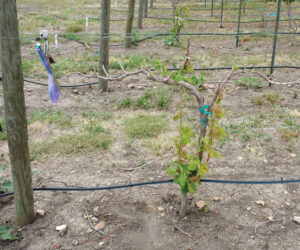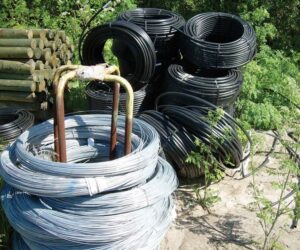‘Talent Borrows, Genius Steals’ -attributed to Oscar Wilde

But instead of finding gaps in our ongoing narrative of backyard viticulture, I discovered a subject that is touched on in almost every article, but never explored thoroughly: vineyard field tripping, or getting out of your own backyard and visiting other vineyards. The purpose of field tripping is to learn from other growers’ mistakes and successes, consider vineyard practices from a different point of view, and then return home with new techniques and philosophies that can improve your grape growing and the wines that you make.
This is the Hero’s Journey of Viticulture. We leave the safety of our home on an adventure of discovery, uncertain what will happen to us when we enter the alien rows of a different vineyard. Will the journey make us feel wise or ignorant? And will we be able to emerge from the adventure with a treasure of new knowledge that we can bring back to our home vineyard to improve our craft?
This short guide to vineyard field tripping will focus on the nuts-and-bolts of getting the most from your vineyard visits. I will guide your planning, execution, and follow-up with the mind of a professional vineyardist and the soul of a wine lover.
Getting out of the house can be a challenge in our busy lives, but the rewards go beyond the simplicity of education and improving our backyard vines. By meeting and visiting other local growers you will be creating a network of friends and acquaintances that will be willing to help you if something goes wrong in your vineyard. You may even want to set up a local vineyard club where local growers can meet once a month at a different vineyard, tour it, make suggestions, taste wine from barrel and bottle, and improve the grapes and wine in your hometown. Home winegrowers and winemaking clubs often use their membership as picking and crushing ‘teams’, traveling together on the weekends to vineyards needing to be harvested. This act of friendship and community illuminates the truth in one of my favorite Chinese proverbs: “Many hands make light work.”
Setting up the appointments
There are really two types of appointments that you can make for a vineyard field trip: a formal appointment at a commercial vineyard or a casual and friendly date with a home owner to see the vineyard in their backyard. Both types of trips will help you in different capacities: the professional vineyardist will be able to provide some pro tips that may or may not help in your specific situation, and the hobbyist visit will give you a more social and casual opportunity to make new friends, discuss the tools and practices of amateur winegrowing, and provides an excellent excuse to eat a hearty meal and open a number of home wines. Most traditional vineyard tours included as part of a winery tour are highly generalized and will not help a more sophisticated hobbyist. Tour guides are also notorious for giving incorrect information concerning wine grape farming.
Here are some tips for making your appointments to visit a professional/commercial vineyard.
- Make appointments at least two weeks in advance.
- Choose a vineyard in close proximity to yours if at all possible, and one that is consistently growing impressive wines in a style that appeals to you.
- When calling for an appointment at a commercial vineyard, ask to speak to the vineyard manager directly. Let the manager know that you are a local winegrower that has heard about the quality and innovation of the vineyard in question.
- Ask if they accept non-paid vineyard interns. (The free part will usually pique a farmer’s interest.) Suggest you would love to come out and put in some work with their crew for free, just to have the chance to see how they farm. Our current vineyard foreman went to work for a professional vineyard management firm for almost two years before we planted our vineyard. We subsidized his pay to make it a great deal for the management company, and he ended up receiving a world-class vine education for a relatively small investment. From a commercial managerial point of view, there is no reason to spend time giving home growers a long and informative tour. There is good reason, however, to accept free labor and spend some time training a ‘free’ employee.
- To visit a home grower/hobbyist, research local growers. Ask nurseries or businesses that provide materials for vineyards/growers who they know locally that grows good wine. Do an internet search with your city and county’s name attached to words like: vineyard, vine(s), winegrowing, viticulture, (specific varietals like Cabernet Franc, Seyval Blanc or Norton), club, organization, meeting.
- Check your State or Community College class schedule for agricultural courses that may cover grape growing. Contact the instructor for guidance or some leads on local growers. Go to wine shops and wine bars and chat up the personnel about local growers and their identities. Usually a ‘ringleader’ emerges in the local winegrowing scene – a man or woman who is the ‘go to’ person for those in need of some guidance.
- If there are no local clubs, meetings, or colleges, or you have aspirations to grow grapes in a region devoid of vineyards, you may have to widen your search, gather what information you can, and use trial and error to discover what practices best suit your specific locale.
- When you find the club or person you are interested in meeting, make yourself valuable to them. Offer to host a meeting or tasting, ask if you can help complete vineyard practices, take them to lunch or dinner. The wine business, both at the professional and amateur level, operates on hospitality and relationships, and is fueled by cuisine and (gasp!) wine. Treat a respected grower like you would a first date: wine them, dine them, make them feel comfortable before plying them for favors.
How close is local?
It’s common for a winegrower in California to think vineyards are everywhere. We can find someone growing grapes within an hour’s drive, and most locales have a commercial winegrowing area within a hundred miles. But if you grow Riesling in Montana, you may not have the same opportunities as I do. I will try to keep this in mind as I discuss vineyard proximity and how it relates to specific vineyard education and practices.
The hobgoblin of all viticultural training is site-specificity. In other words, it is very difficult to give meaningful winegrowing advice in a national magazine. What works in Kentucky is not going to work in Michigan. This is why I constantly suggest seeking out local expertise. But how close does a vineyard have to be in order to be considered local? How distant is too distant when it comes to learning practices in the backyard vineyard?
To answer that question, you may need to do some research. With the advent of the internet and nifty computerized weather stations, this may be easier than you think. In the same manner that we may look for changes in natural vegetation or drainage on a site being prepared for vine planting, we can ask ourselves some fundamental questions concerning climate and exposure to determine if a site we visit can be considered local, which for our purposes is defined as a region from which we can glean specific information and practices to be used in our own vineyards for the purpose of increasing fruit quality.
Criteria that suggest the vineyard is local
- The vineyard shares similar weather as yours: rainfall within a few inches annually, similar spring and summer weather patterns including high temperatures and degree day accumulation.
- Tradition dictates planting of similar grapevine varietals.
- Consistency of soil profiles.
- The vineyard is within an hour’s drive or 100 miles of yours, although this is not always true in areas that have geologic anomalies that cause drastic weather or soil changes, such as coastal areas, mountains or volcanos. For instance, in the Santa Ynez valley of Santa Barbara, California there are several east-west valleys over the course of only 30 miles between Lompoc and Lake Cachuma, and they host 60 different winegrape varietals.
- The vineyard shares similar native vegetation and fauna. Get to know what weeds and native plants grow on your property, inventory them with a field guide, and check other nearby vineyards to see if the same vegetation is present in their backyard. This may be the easiest method for determining whether another vineyard is similar to your own. This is known as using “indicator species.”
- The vineyard shares the same American viticultural area, or is considered by academics to be similar geologically and climatically.
- The sites look and feel similar.
Making the visit meaningful
Now that we have clear criteria for finding a local vineyard that will guide your vineyard practices through field tripping, let’s make sure the time you spend ‘on the road’ will bear fruit.
Take along a small notebook and pen to write down your impressions, ideas, sketches, phone numbers, equipment specifics, descriptions and methods for cultural practices and data that emerge during your tour and work. Check out WineMaker’s Web site for a printable sheet of questions you can bring on your visit.
Bring data on your vineyard. Some data you may find handy: high/low temperatures and degree day accumulation between June and October, a list of native plants and weeds, a list of the equipment you use (with model numbers) to compare, soil reports or even a bag of soil from rooting depth, and the only data that really matters in the end: a few bottles of wine from your vineyard to share.
Bring a willingness to work hard and improve the vineyard you’re visiting. Be open to new ideas and don’t try to show off too much. A good student both listens and participates, and if you are trying to learn from another vineyardist don’t second guess them or correct them repeatedly. If they are obviously ignorant, just be polite and make a short day of it.
Also take time to discuss your trip and what you learned on the way home, or make a presentation to a winegrowing club or friends who grow wine. We only remember about 40% of what we read, and 60% of what we write, but keep 90% of what we experience and teach someone else. Integrate your new ideas into your farming as soon as possible, and be careful to monitor the effects.
Following up in your own vineyard
Field trips are a great way for us to escape our own world and experience a different environment from which we can learn. It’s common for us to become insular and automatic in the way we farm. The more we ‘get out’ and experience winegrape production from a neighbor’s point of view, the clearer we can see our own practices in context.
Growing grapes has always been about intuition, innovation and imagination. No other agricultural product is afforded such adoration as wine, and no other agricultural product can tell such a story by virtue of its flavors and nuances. What flows from the bottle is a tale of passion, planning and execution. Great winegrowers are always asking themselves, just like great artists, “What can I do next time to improve my craft?”




